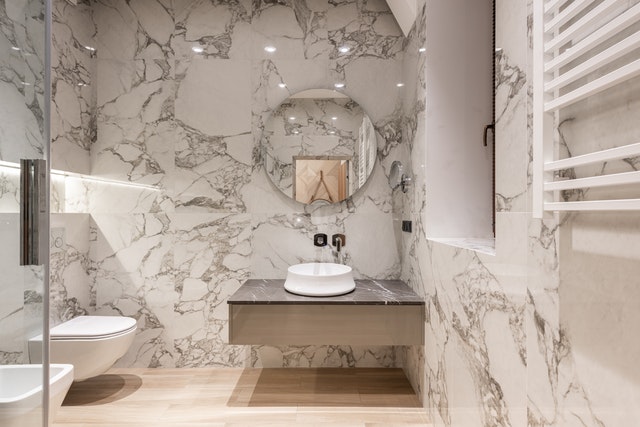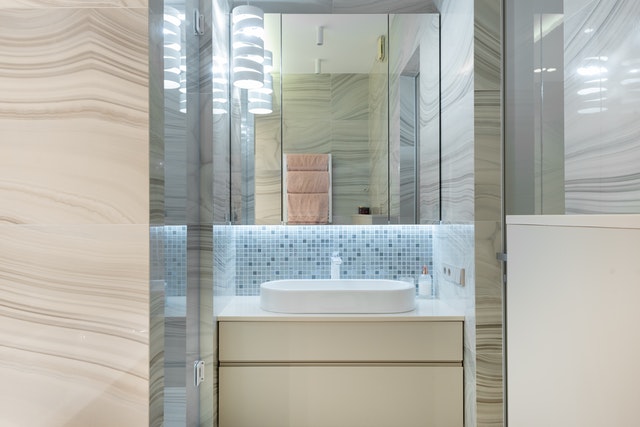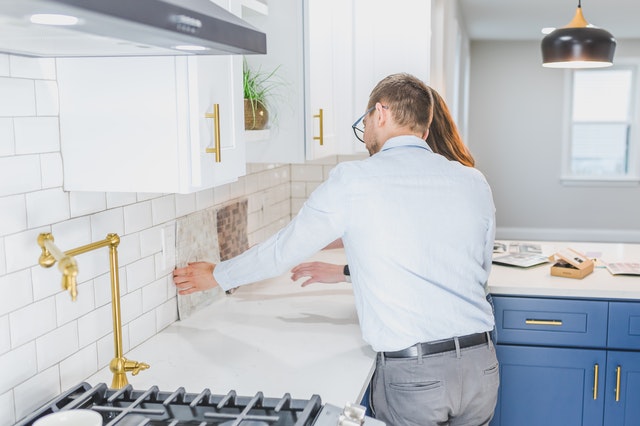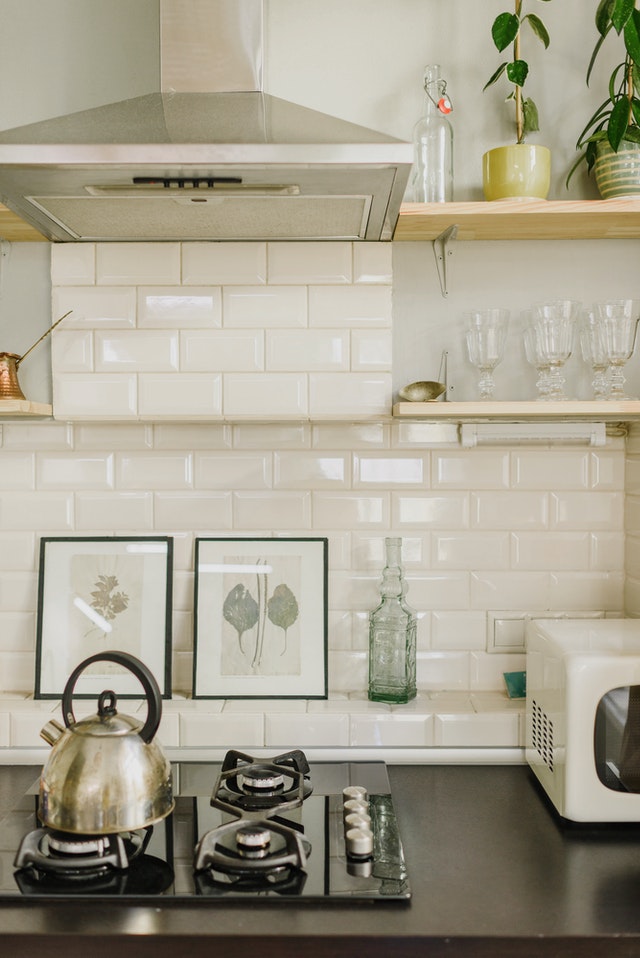Setting sheets of tile
Backed tile. Some tile comes in sheets several tiles square, the tiles attached to one another with flexible grout. Set sheets of backed tile, using the techniques shown for individual tiles. If one or more tiles in a sheet must be cut to fit around pipes or fixtures, cut the affected tiles out of the sheet with a razor blade and trim away the cut grouting. Set the remaining tiles in the sheet, then cut the detached tiles to fit around the obstacle. Set the cut tiles and, after 24 hours, regrout around them with silicone rubber grouting.
Mosaic tile sheets. Most mosaic tile comes in sheets held together not by grout but by paper on the face of the tiles or by mesh on the back. Roll up the sheet with the back of the tile on the outside. After troweling on adhesive, place the free edge of the sheet where it is to be set and gradually unroll the sheet, pressing the tiles gently into the adhesive. Do not slide sheets into place. Space sheets the same distance apart as the tiles in the sheets. The mesh on mesh-mounted tiles remains in place under the tiles; the paper on paper-faced tiles is removed after the tiles are set by dampening it and peeling it off.
When mosaic tiles must be cut to fit a space, cut the affected tiles out of the sheet, then trim them as necessary and set the cut tiles individually.
Finishing techniques
Grouting. Mix grout to the consistency specified on the label. Trowel it into the joints and spread it with a window-washing squeegee or stiff card-board. After about 15 minutes, wipe up excess grout with a damp sponge, rinsing the sponge frequently. When all grout has been removed, let the tiles dry; polish with a soft cloth.
Applying silicone grouting. Use a caulking gun with the tip cut at a 450 angle to grout between sheets of backed tile with mildew-resistant silicone rubber seal. Fill joints to the same depths as the grouting between tiles. Also grout around any tiles you have set individually. When the silicone rubber is tacky, clean the tiles around the joints, using alcohol on a soft cloth.
Sealing grout. A good way to keep grout joints from becoming discolored by dirt or mildew is to seal them with a penetrating-type liquid water-repellent sealer after the grout has cured for 28 days On walls, apply the sealer to the grout joints with a small brush such as a watercolor brush. On floors, spread the sealer over the joints and wipe up any excess with a soft cloth.
Sealing tile flooring
Sealing the flooring. Apply a commercial tile sealer periodically to the flooring to help protect it and ease regular maintenance. Consult a tile dealer for the tile sealer recommended for your type of flooring; if it is of glazed tiles, a tile sealer is not necessary. Clean then tile flooring using a nonacid commercial floor cleaner, then follow the manufacturer’s instructions to prepare and apply the tile sealer. Wearing rubber gloves, work from one end of the flooring to the other end of it on a small section at a time, wiping the tile sealer onto the surface with a clean, soft cloth or mop; do not pour the tile sealer directly onto the flooring. Apply only a thin, uniform coat of the tile sealer and wipe off any excess; allow the flooring to dry overnight. If the flooring is of glazed or other tiles that do not require sealer, apply a commercial grout sealer of liquid silicone to the grout. Following the manufacturer’s instructions, spray the grout sealer onto the surface or apply it with a soft cloth, immediately wiping up any excess; allow the flooring to dry overnight.
Accessories for bathroom walls
The essential bathroom accessories-soap dishes, towel bars and toilet-tissue holders- and many less essential ones are available in three types. Flush-set accessories mount on the wall much like tile or paneling; they are installed at the time the wall covering is applied. Recessed accessories, applied at the same stage of wall finishing, are, as the name suggests, fitted into holes in the wall. The third type, surface-mounted accessories, can be installed at any time over the wall covering; some are merely glued on, but the ones held by screws and mounting clips are generally sturdier. The methods of fastening the accessory to the clip depends on whether the accessory is ceramic or metal.
Vertical or L-shaped grab bars, resembling towel racks but more sturdily mounted, are a useful addition to any bathroom. Like other surface-mounted accessories, they are fixed on top of the wall covering. But plastic anchors should not be used to hold the mounting screws for a grab bar. Some people use hollow-wall fasteners, but it is better to screw a grab bar directly into wood blocking placed behind the wall at the time of framing the room with studs and other supports.
If a wall is being tiled, flush-set accessories are generally installed. Leave an opening for them at the time of tiling, cutting tiles as needed to trim the edges of the space. When setting or replacing a flush-set accessory, use plaster of Paris rather than tile adhesive to bond it to the wall. The plaster grips every little crevice slightly as it sets, strengthening the bond.
Recessed accessories can be installed in any wall that can be cut, and are suitable for tiled walls if a space for them is planned and the underlying material is cut before tiling. The small opening in the wall must be cut to the same dimensions as the accessory’s recessed part, the edges at least 1 ½ inches from a stud.
Surface-Mounted Pieces
Drilling tile. Locate accessories so that their screw holes are as near to the centers of tiles as possible. Use rubber cement to stick a piece of thin paperboard, such as a file card, where the accessory is to be fastened. Hold the mounting clip for the accessory against the card and mark the screw holes. Drill with a masonry bit and a variable-speed drill at low speed; apply light p[pressure to avoid breaking the tile. After the holes are drilled, peel the paperboard from the wall.
Installing Ceramic accessories. Screw the metal mounting clip into plastic wall anchors, setting it with its thickest end up. Slide the accessory down over the wedge-shaped clip until it fits snugly against the wall. Grout the joint between the accessory and the wall.
Installing metal accessories. Attach the clip to the wall as shown above, with its angled parts at top and bottom. Place the setscrew in the bottom of the accessory Slip the top of the accessory over the top angle of the mounting clip and drop the bottom of the accessory over the bottom of the clip. Tighten the setscrew against the bottom of the clip with a small screwdriver.
Flush-set Accessories
Mixing the plaster of Paris. Add water slowly to a pound of plaster of Paris in a mixing bowl, stirring constantly. Mix just until the material holds its shape and peaks in the bowl like stiffly beaten egg whites. Avoid excessive stirring; too much air in the mixture will speed setting time. Trowel about a ¼-inch layer onto the back of the accessory, slightly thinner toward the edges.
Setting the accessory. Press the accessory firmly against the wall while wiggling it to force the plaster of Paris into irregularities around and behind the adjacent tiles. Wipe off plaster that oozes out the sides of the front flange. Hold the accessory in place until the plaster stiffens, usually a minute or two. The next day, grout around the flange.
Recessed accessories
Positioning the hanger bracket. To install a recessed accessory that was planned before the wall was surfaced, screw it directly into wood blocking between studs. For installation after the wall is surfaced, cut and finish the opening, then use a winged bracket to secure the accessory behind the wall. Slip the first coil of the brocket sprang over the center of the bracket with the remainder of the spring pointing away from the spread tabs. Angle the bracket into the recess, spring first, and position its tabs against the back of the wall surface. The spring, pushing against the far side of the wall section, will hold the bracket in place.
Mounting the accessory. Place a bead of colorless caulking compound around the black of the front flange on the accessory. Insert the accessory into its opening. Put one of the mounting screws through the accessory and engage it in the slot in the mounting bracket. Tighten the screw a turn or two. Do the same with the other screw and then tighten both of the screws to hold the accessory in place.





